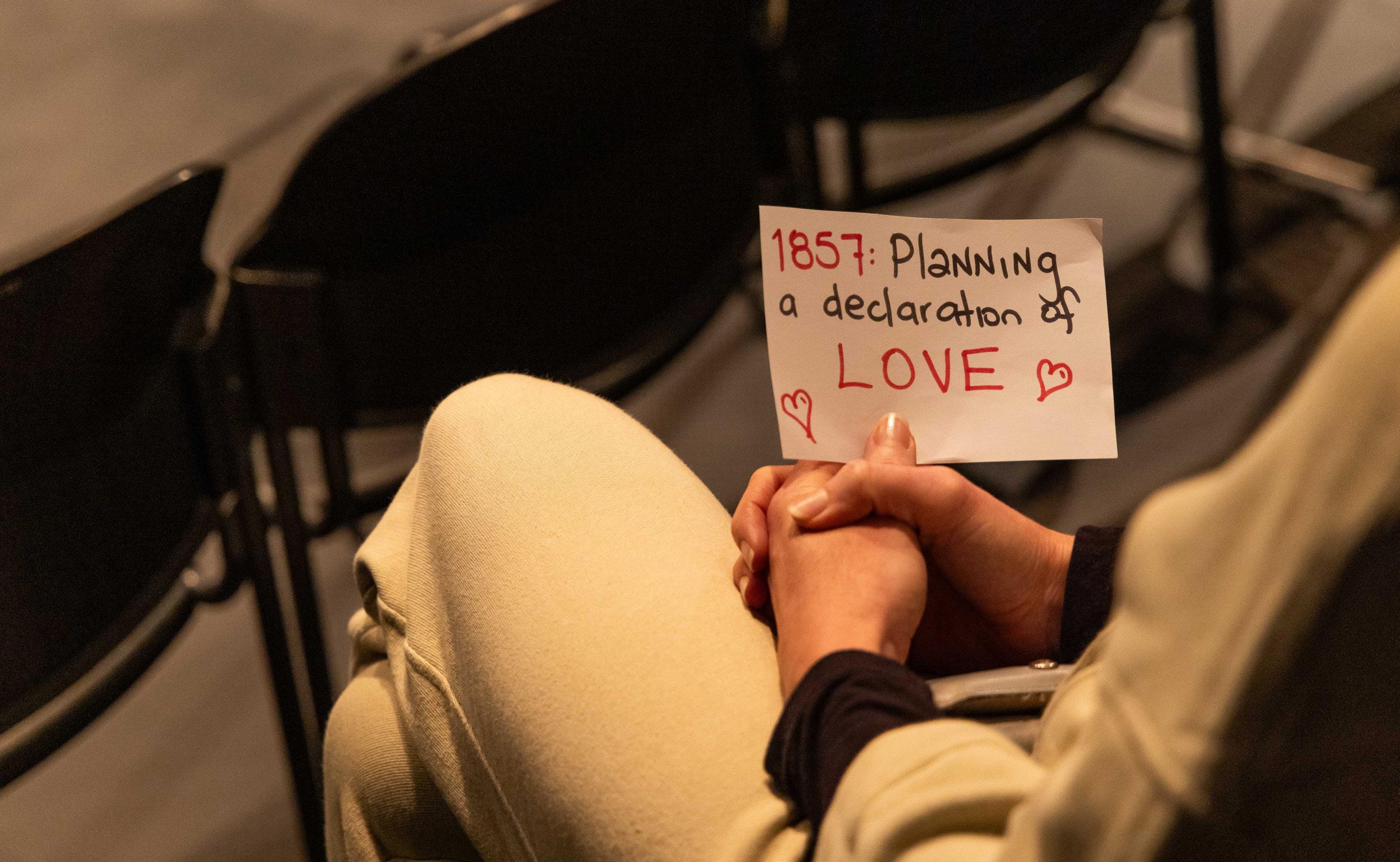








































Step into a world where screens and algorithms fade into the background and experience the power of genuine connection in real time and space. Together, let’s craft something unforgettable.
Over 80 minutes, EveryBrilliantThing brings together a group of strangers in a way that only live theatre can—reflecting what it is to be human in a shared and immediate experience. A seven-year-old’s mother attempts to take her life, but what does a seven-year-old do to make sense of it and to help the most important person in their life to see all the reasons to be happy; to see every brilliant thing?
Playfully pieced together with direct involvement from the audience, our narrator takes us back to how the list of every brilliant thing started. Every BrilliantThing is funny, sad, uplifting, and honest; it is a truly unique theatrical experience.
If you had to make a list, where would you start?
#1 Ice cream
#2 Water fights
#5 Things with stripes
#25 Wearing a cape
#314 The way Ray Charles sings the word ‘you’
#319 Laughing so hard you shoot milk out of your nose
#823 Skinny dipping
#9998 Watching someone watch your favourite film









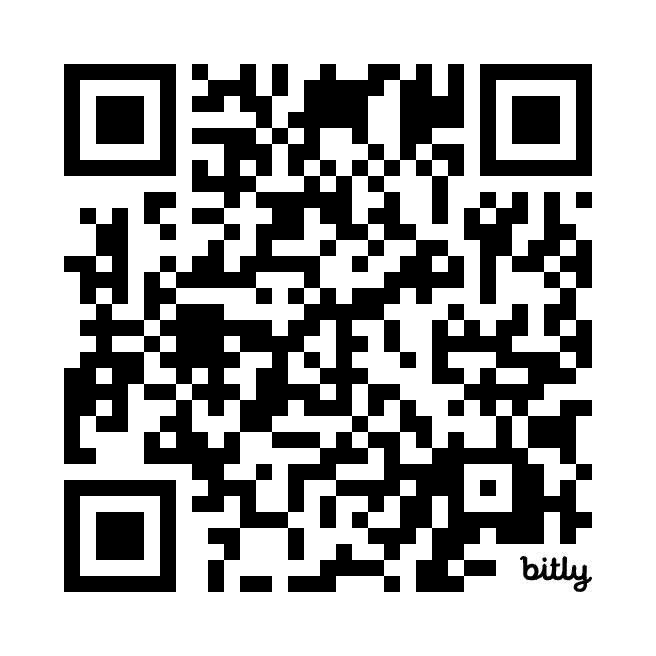






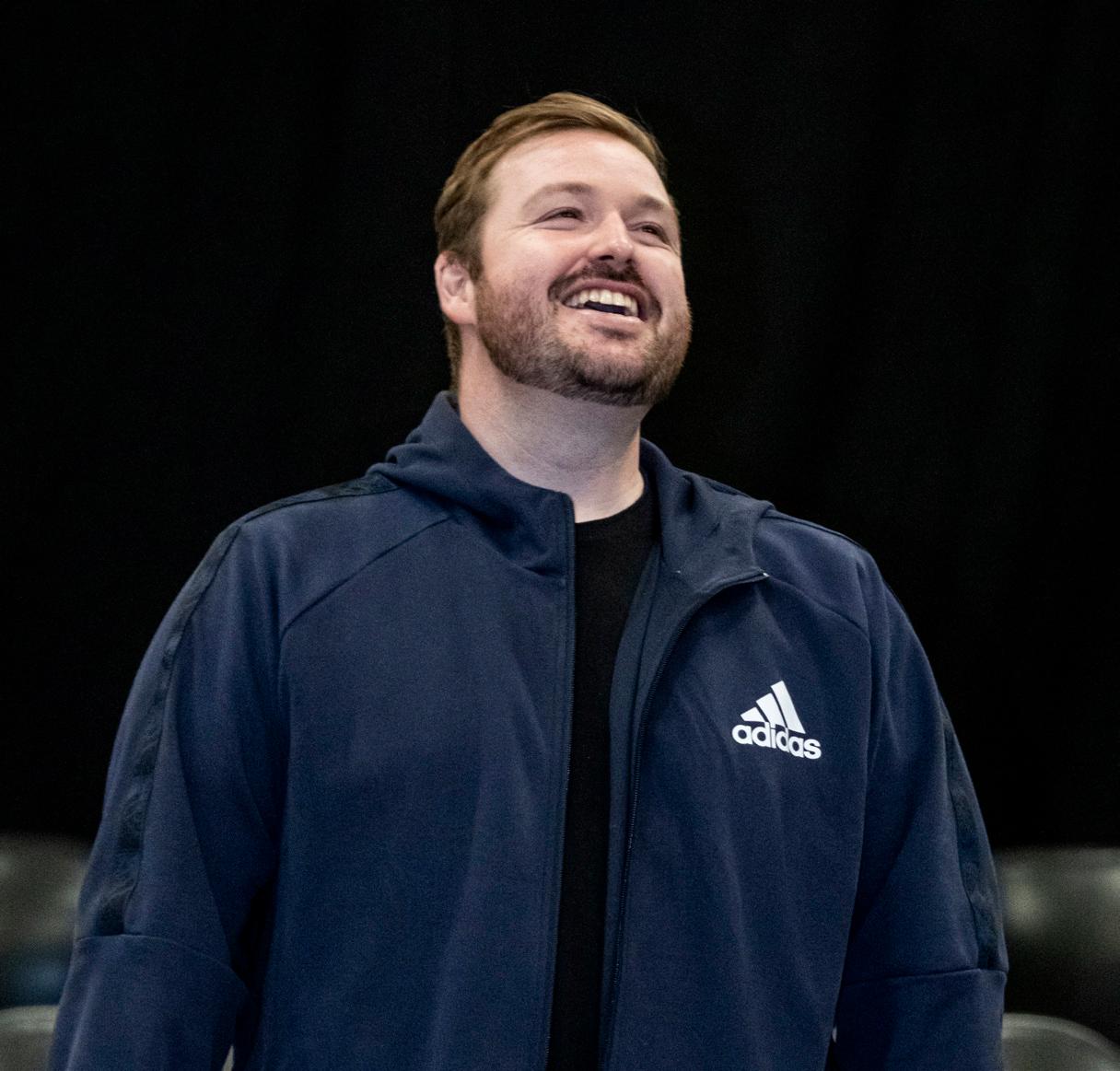
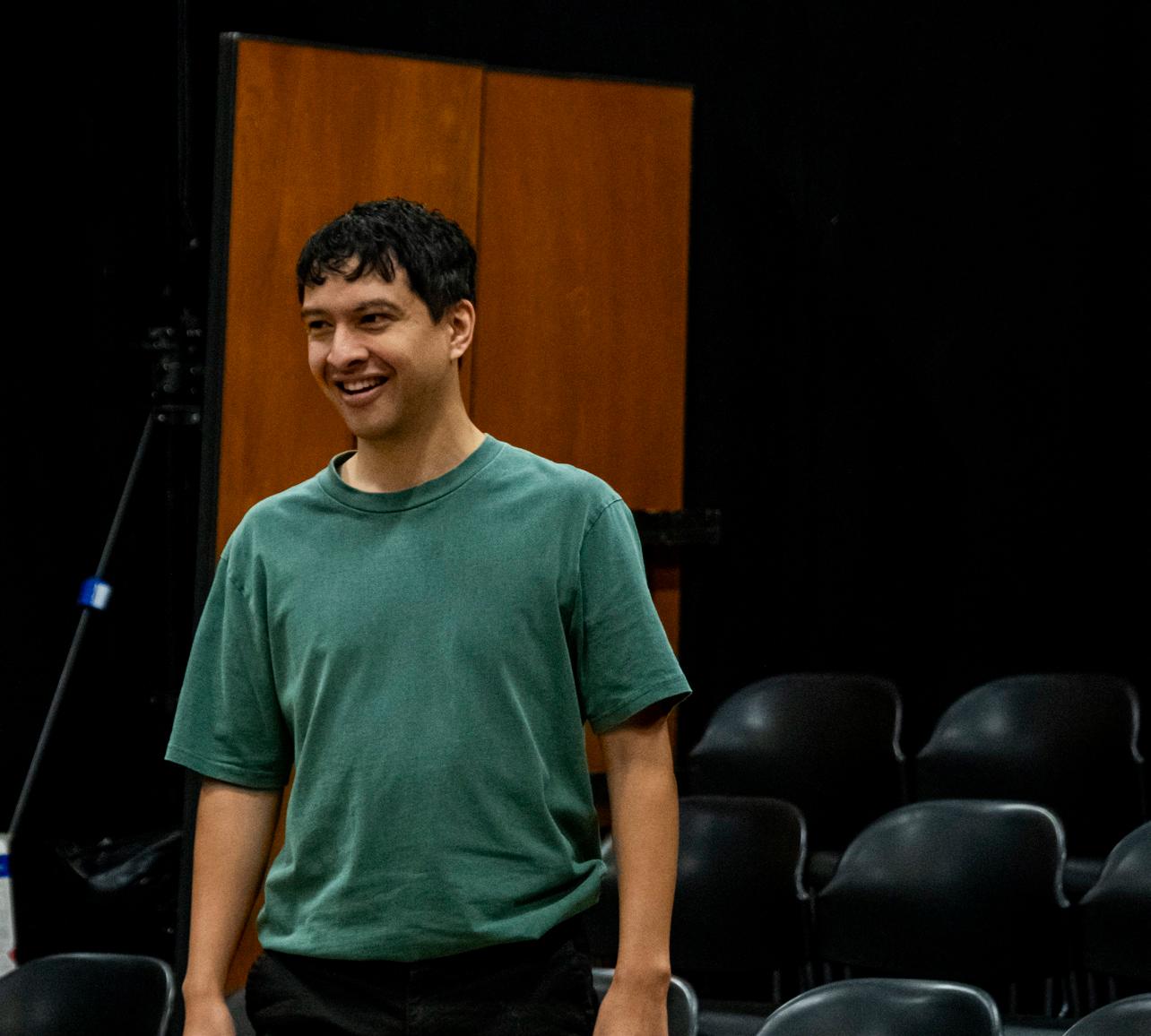

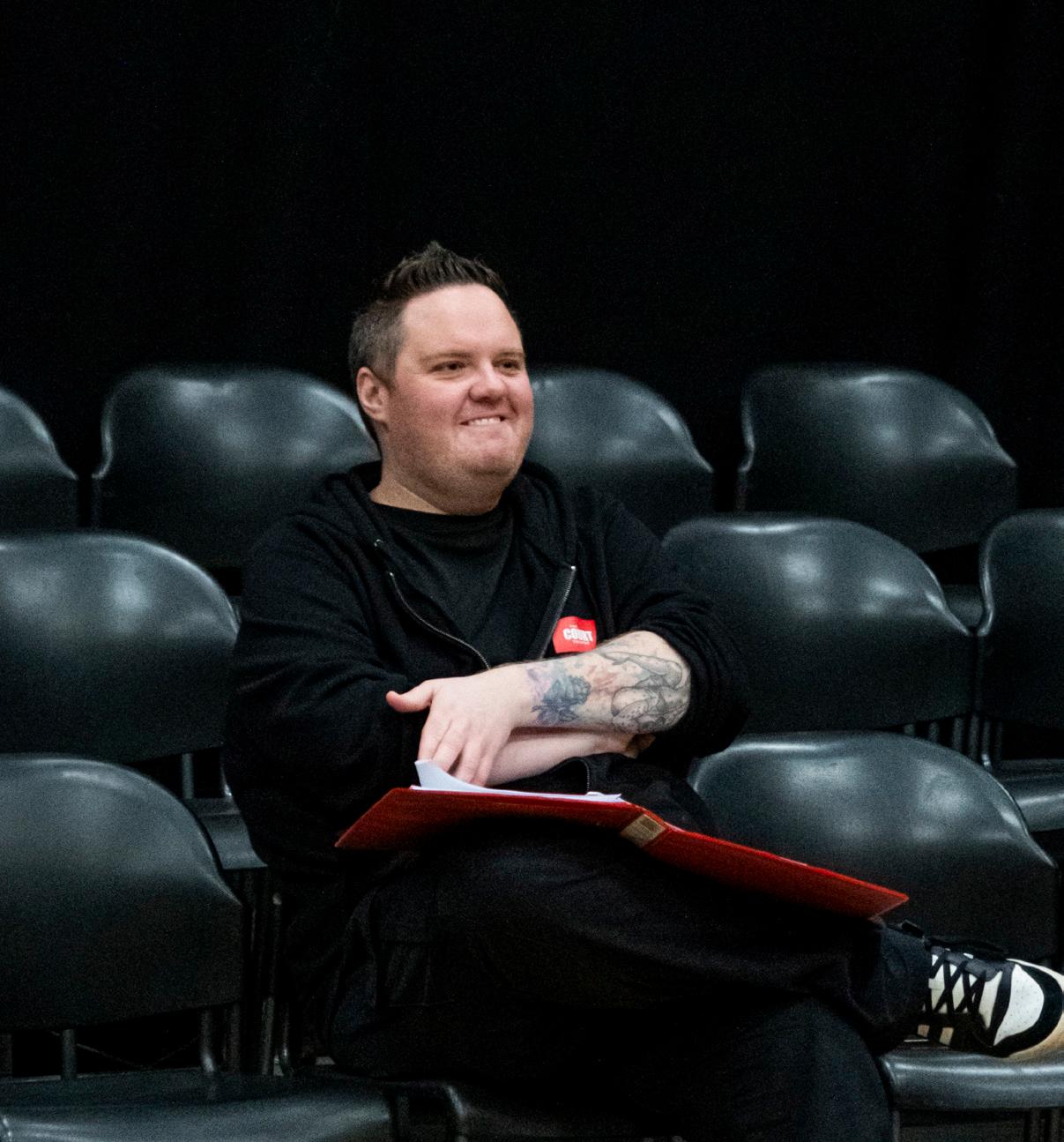





Duncan Macmillan is a writer for theatre, television and film. His theatre work includes Lungs, People, Places and Things, Every Brilliant Thing, Rosmersholm (adapt. Henrik Ibsen), 1984 (adapt. George Orwell, cowritten and co-directed with Robert Icke); City Of Glass (adapt. Paul Auster) and 2071 (co-written with Chris Rapley). Other works includes The Forbidden Zone, Wunschloses Unglück (adapt. Peter Handke), Reise Durch die Nacht (adapt. Friederike Mayröcker) and the English language version of Thomas Ostermeier’s An Enemy Of The People (Duke of York’s Theatre). His work has been performed throughout the world, including the National Theatre, the Old Vic, the Royal Court, Almeida, Barbican, St Ann’s Warehouse, Melbourne Theatre Company, Berliner Ensemble, Hamburg Schauspielhaus, Schauspielhaus Köln, Burgtheater Wien, Vesturport, Kansallisteatteri, Nationaltheatret Oslo and in the repertory of the Schaubühne Berlin, as well as the Edinburgh Festival, the Manchester International Festival, Salzburg Festival, Festival d’Avignon and Theatertreffen, in the West End and on Broadway.
His screen work has appeared on the BBC, HBO, Netflix, and at the Berlin and London Film Festivals. ReiseDurchdieNachtwas awarded the Nestroy Preis for Best German Language Production. Both 1984 and People, Places andThingswere nominated for Best New Play at the Olivier Awards, and Rosmersholm was nominated for Best Revival.



Jonny Donahoe is an actor, comedian, playwright, and screenwriter. His one-man show EveryBrilliantThing,(which he co-wrote and originally performed), has played more than six hundred times over four continents, including five months off-Broadway at The Barrow Street Theatre. The show was filmed by World of Wonder and screened as a special on HBO. He was nominated for a Drama Desk Award, Lucille Lortel Award, and an Off-Broadway Alliance Award for his performance. He is the frontman of musicalcomedy-satirists, Jonny&TheBaptists, as well regularly performing stand-up in his own right. His play Thirty Christmases (starring himself and Rachel Parris), premiered at the Old Fire Station in Oxford, before transferring to the New Diorama Theatre in London. He has also created a twelve-part series on parenthood with real-life partner Josie Long called Josie & Jonny Are Having a Baby (With You!) for American podcast network Midroll. More recently Johnny has written the acclaimed new play Forgiveness which toured the UK and internationally in 2022.

EveryBrilliantThing is a heartfelt and uplifting play that follows the journey of a protagonist who learns to cope with difficult emotions and find joy in the little things. Written by Duncan MacMillan, this one-person show invites audiences into a world of laughter, tears, and resilience.
The story revolves around a young person who decides to create a list of “brilliant things” as a way to cheer up their mother, who is struggling with depression. From simple pleasures like “ice cream” and “puppies” to more complex experiences like “the feeling of accomplishment” and “falling in love”, the list grows over time, becoming a source of comfort and hope for both the protagonist and their mother.
As the protagonist grows older, they encounter various challenges and setbacks, but they continue to add to their list, finding solace in the beauty and wonder of everyday life. Along the way, they meet people who leave a lasting impact—a caring teacher, a compassionate friend, a kind stranger— each contributing to the ever-expanding catalogue of “brilliant things”.
Through a blend of humour, honesty, and vulnerability, EveryBrilliantThing explores themes of mental health, resilience, and the power of human connection. It celebrates the importance of finding joy in the midst of adversity and reminds us all that even in our darkest moments, there is light to be found.
This play is a reminder that life is full of beauty and possibility, and that even the smallest gestures of kindness and love can make a world of difference. It encourages audiences to embrace the brilliance of being alive and to cherish the precious moments that make life worth living.

Filled with laughter, tears, and moments of profound insight, EveryBrilliant Thing is a captivating theatrical experience that will resonate with audiences of all ages, reminding them of the extraordinary value of life’s simplest pleasures.
Hillary Moulder is an accomplished performer with a Diploma in Performing Arts. She proudly holds associate credentials in Modern and Tap from the International Dance Teachers Association and is a proud member of Equity New Zealand.



Hillary has performed in productions such as Chicago,JesusChrist Superstar,JerseyBoys,TimeMachine,LesLiaisonsDangereuses,A StreetcarNamedDesire,AChristmasCarol, and EscapefromHaunted House. Additionally, she showcased her choreographic talent in Ladies Night,Once,FlagonsandFoxtrots,NexttoNormal,MatildaTheMusical, ThatBloodyWoman, and directed the enchanting shows Sense and Sensibility,AFlightBeforeChristmas and now EveryBrilliantThing.
Hillary’s repertoire encompasses diverse works such as Matilda The Musical,BeautyandtheBeast-ThePantomime,AFineRomance,WeWere Dangerous (Piki Films), ChatswithPat,Nine,ShortlandStreet,Oliver,Meand MyGirl,AliceinWonderland,TheWasps, and Hamlet. She has also had the privilege of performing with institutions like Disneyland Paris and the Royal New Zealand Ballet.
Hillary is a strong supporter of equality, diversity, and the power and importance of acceptance in theatre and the world alike.
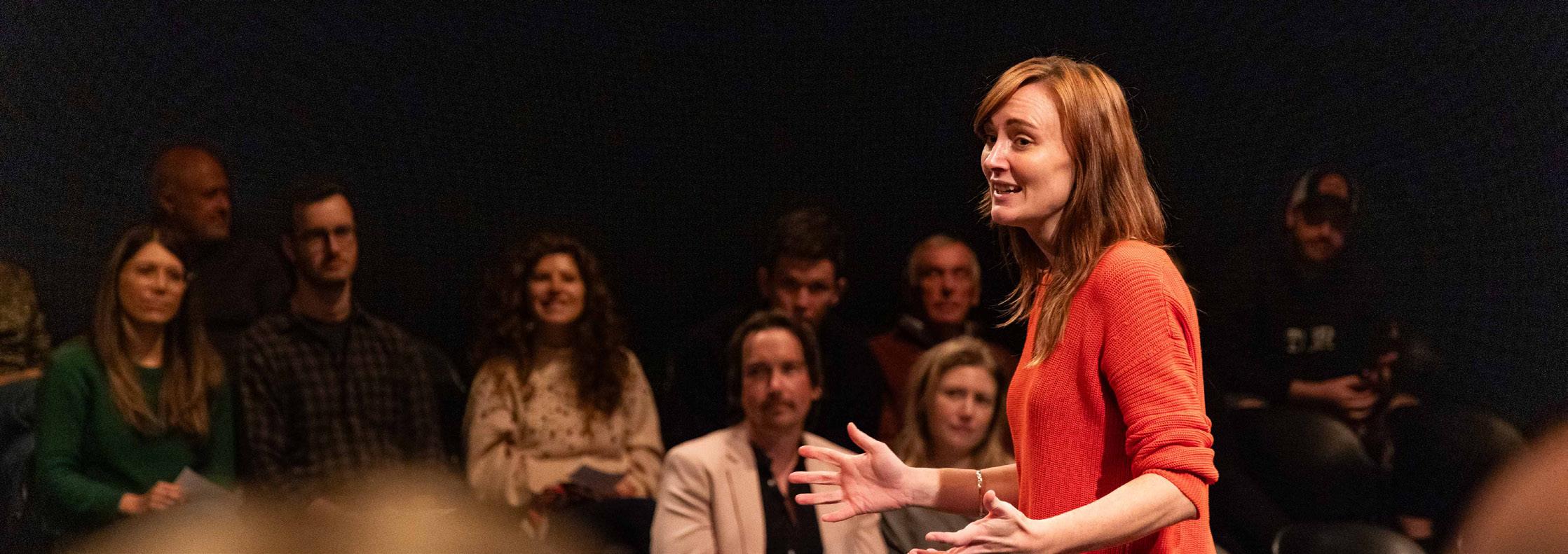
We sat down with Hillary Moulder to learn about her approach to the play and the vision she had for bringing this important and serious topic to the stage with care and humour.
How did this play impact you when you first encountered it?
The play hit me with every emotion on the first read. I had a story in front of me that was special. It scared me, excited me, made me laugh, cry, hurt, forgive, heal and so much more.
How do you approach directing a one person play that has two actors playing the same role?
We went through each part of the story in turn with both actors always in the room. We created a space for them both to deliver the text honestly and individually but with the same goal of what we are trying to achieve to best serve the text.
What is the role of the audience in the work?
The role of the audience is to be present and engaged. They are a part of the telling of the story. They are called upon to read entries from the list and give colour and life to some wonderful and important people in the storyteller’s life.

What do you hope the audience takes away from the play?
I hope the audience walk away feeling something. I can’t say what they will feel because it’s an experience that will affect people differently. I do hope that they will be encouraged to find comfort in the everyday small wins in an ever increasing world of losses.
A key aspect of this play is that it is staged in the ‘round’. What did you have to consider when directing a show for the round?
B eing in ‘the round’ allows all to be in a space where we can see and share energy with those all around us and be a part of the experience together. The performers have to acknowledge and connect with everyone. The direction of the two cast members was predominantly based on the rhythm and energy created by the story and how they delivered it. This could change each night.
Unpacking important evidence from a director’s interview
Being able to unpack the director’s concept in either your report or your exam answers and connect it to how the performance used drama components allows for more depth in your answers. This activity will help you pull out information from the interview with the director Hillary Moulder that you could incorporate.
• Highlight quotes that support how technology was used in the performance was used to communicate a message or idea.
• Underline ideas that surprise you or you would like to discuss further.
• Circle ideas or quotes that are connected to the relationship between audience and the characters.
Once you have made these notes, reflect on them with a partner and see if any of their ideas enrich your own.
Put your underlined ideas on the class whiteboard as ideas that your teacher can support you to discuss further.
Theatre’s ability to heal, educate, entertain and transform Level one students discuss theatre’s ability to heal, educate, entertain and transform the audience. These ideas also help us to deepen our understanding of why audiences might go to theatre and how they might come away feeling and thinking afterwards.
In her interview Moulder mentions the following about EveryBrilliantThing: “It scared me, excited me, made me laugh, cry, hurt, forgive, heal and so much more.”
In a short essay or voice note think about the following questions:
• What did the performance make you feel and think about?
• Out of the four words, heal, educate, entertain and transform - which word do you think applies to EveryBrilliantThing the most and why?
• Add details about the audience’s response to the performance.
• Incorporate ideas from the wider pack, including quotes from the interviews.
While never referred to as the Narrator in the play, this is the main character who takes us on the journey through his life and his list of brilliant things. Played by the same actor throughout the play, he shares his story moving through the years from a seven-year-old through to adulthood.
And, played by various audience members:
• Vet
• Dad
• Audience
• Sock
• Lecturer
• Sam
• Mrs. Patterson
Cast
Our production of EveryBrilliantThing has two actors sharing the main role. They alternate performances so that each show is entirely performed by the one actor.

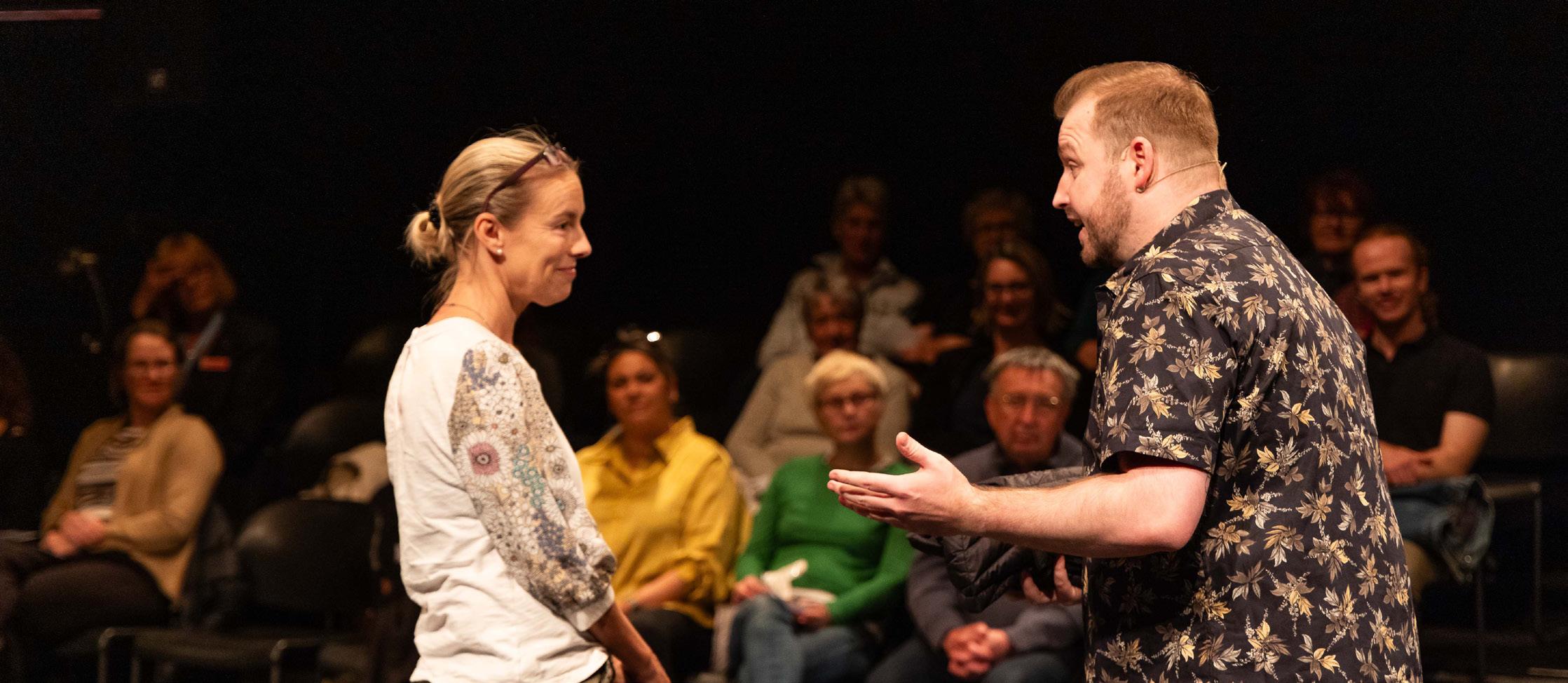

Trubie-Dylan Smith
Trubie is best known for being an entertainer and presenter on the Sunday morning kids’ show What Now? (Whitebait Media).

His previous Court Theatre credits include ThePrincessandTheFrog(andTheRobber!) and The Wind in the Willows. He was also a Court Jester, regularly performing in Scared Scriptless.
His other theatre credits include BeautyandtheBeast-ThePantomime (GMG Productions), He Kura Kōrero (Circa Theatre), TheBaldSoprano (Arcade Theatre Company), KingArthur (Rollicking Entertainment Ltd), RedRidingRobynHood and ShakespeareAsYouWriteIt (New Zealand Playhouse Tour 2018).
Trubie has performed as an improviser throughout New Zealand, the US and Canada. He was the Creative Director of Dunedin improv troupe Improsaurus and coached improv in Otago from 2008.
Nick Purdie
Nick’s (he/him) previous Court Theatre credits include BloodBrothers,MaryPoppins, LegallyBlonde:TheMusical,JerseyBoys,NexttoNormal, and SomethingRotten!.
Most recently he was the Associate Director for both New Zealand and Australian tours of the Selladoor Worldwide production of MadagascarTheMusical and appeared in the New Zealand tour of JerseyBoys.
Other notable credits include Onstage Swing in The Sound of Music (West End Palladium International Tour), Bert in MaryPoppins (Invercargill Musical Theatre), Twilight Robbery (York Stage, UK), Sister Act (Showbiz Christchurch and Invercargill Musical Theatre), AltarBoys (Fortune Theatre), Corny Collins in the New Zealand Premiere of Hairspray (Wellington Musical Theatre), and Underscore_ and GardensMagic (WITCH Music Theatre).
Off stage, Nick is an Associate Producer for global theatre producers, GMG Productions.


We spent time with Trubie and Nick to understand what it was like preparing for this role, to discuss the creative choices they made and how they handled the unique challenges.
What first drew you to the play?
The off-the-cuff nature of the play, the audience interaction (I love audience input/ participation) and the content; I love exploring the sad stuff with a brave and smiley attitude.
I actually hadn’t heard of the show before the season was announced. I was sent the script by our wonderful director to read and after that I immediately knew it was something I would love the opportunity to be a part of. It is such a clever script with such an important message. It also is very different to anything I’d ever really seen or been a part of in its performance style. The thought of being a part of the show absolutely terrified me also (for all the right reasons). I knew that it would be a massive challenge and facing that challenge would really push me and I could learn so much from it.
How have you approached this character?
There’s not much character prescription. The narrator is unamed and the delivery is quite factual. Though the character has been through some dark stuff, they’re not indulging in sorrow or pain. In some ways, this is like one big Ted Talk!
From the get go it was so important to approach this character and the story with
absolute truth and sincerity. It requires warmth and hope and a real genuine touch to really speak to people and take the audience on this journey with you. It’s been really important to be open to a collective interpretation of things and working with everyone in the room rather than a pre-conceived idea of what you do at each stage or at different moments in the show. Before rehearsals my main focus was to be as clear as I could on the overall story and be off book as much as possible to really be able to explore the text. Trying not to attach too many choices or emotions to the text before getting in the room where we could explore it all together. Also you then allow yourself to find things in the moment a lot easier.
What has the process been like having two actors play the same role?
It’s a joy. Tackling this piece with Nick, a friend and someone who I’ve worked with closely before, has meant I’ve had immense support and lots of fun. You can learn a lot from your role watching someone else interpret it. It’s also fun to learn the ways that you’re different from other actors! Sometimes Nick will do something and I’ll try it for myself. Sometimes it will work, sometimes it won’t!
It’s been an absolute joy getting to work alongside Trubie in creating this show. We both have very different backgrounds and
specific skill sets and it’s been wonderful to be able to learn from each other and bounce off each other in the room. It also gives you a really different insight into the text from time to time and different interpretations can really help unlock certain aspects of the script and the story we are telling.
An integral aspect of the play is the audience participation. How have you approached this?
With care and control. You’ve got to make the audience feel safe and empowered (or else the rest of the audience will be worried they’re next). You’ve got to make an exciting experience that the audience want to be a part of. Listen to everything the volunteers give you and treat it like a gift.
This is something that’s pretty new to me so it was a little scary to begin with. Just worrying about being able to think on your toes so quickly. But working with Trubie (a very skilled improvisor) and Hillary has somewhat squashed the initial fear of these moments. Securing an arsenal of tools to use in these interactions as well as having the script and story solidly in you means you can have fun with these interactions and not need to stress. We never know what’s going to happen and that’s one of the things that makes this show so joyous and exciting. What initially started as a fear of these moments has now becomes something I look forward to the most.
has been challenging about EveryBrilliantThing?
Learning 47 pages of solo material! There’s a lot to do and you’ve got to do more than just repeat, repeat, repeat the lines. You’ve got to connect all the thoughts in the writing so they make sense to you. That requires a lot of time (which I have) and discipline (which I’m learning to have).
There are many challenges associated with
a piece like Every Brilliant Thing. There are the obvious ones like learning alllllll the lines, and remembering the order and the numbers throughout the show. The subject matter at times getting pretty heavy also. But a real challenge in this piece is keeping the dialogue and the delivery very natural and very matter of fact. Not getting caught up in the emotion of it all and ‘acting’ too much and just letting the focus be on this really important story. You are playing against a lot of the time which can feel unnatural but ultimately is the best treatment for the story and the subject matter.
Do every show you can! Can you see a project that makes you excited? Audition! Ask to be involved! Half of getting involved in theatre is developing your initiative and showing that you want to be in it. Also, be kind to your fellow theatre makers. You’re doing something vulnerable and special so make it awesome for each other!
This is a very common question for someone working in the industry and I always come back to the same answer. You can’t just want to do it. You have to NEED to do it. It’s by no means an easy industry to be a part of but it is very rewarding in many ways but you have to have that need to keep pushing yourself forward. Do all the workshops, do all the auditions, put yourself out there, see a wide range of shows and theatre styles. You will learn so much for every one of these things. Become part of teams on and offstage to get a really well rounded view of the process and way theatre works. And above all else, just be a person that people would want to have in their cast or be around. It’s amazing how far that will get you in the industry.
Connecting the actors intentions with how they performed
Being able to unpack the actor’s interview in either your report or your exam answers and connect it to how they created the character in performance. This activity will help you pull out information from the interview with the actor you watched, that you could incorporate.
• Highlight quotes that support how the actor used techniques in the performance.
• Underline ideas that surprise you or you would like to discuss further.
• Circle ideas or quotes that are connected to the relationship between the audience and the actor.
Once you have made these notes, reflect on them with a partner and see if any of their ideas enrich your own.
Put your underlined ideas on the class whiteboard as ideas that your teacher can support you to discuss further.
Every Brilliant Thing deals with heavy content and themes, which if dealt with in a heavy handed way could have been damaging for an audience. The way the script was written, the direction given to the actors and the staging are all part of supporting the audience to think about the key messages and themes of the performance. The main component of endearing an audience to a show is the actor and their use of techniques to provide light and shade, humour and tension. This activity will help you think about how Trubie and Nick used their techniques to do just that.
In pairs or in a small group, answer the following questions - how did Trubie and Nick use:
• Their voice to tell the story? Think about tone, pitch, pace and pause.
• Their gestures, eye contact, facial expressions and body language to connect with the audience?
• Space to connect with the audience? Think of specific moments when proximity and movement through the space were used to build rapport.
• The quality of their movement to create moments of light and shade, build tension and also alleviate tension?
• Incorporate ideas from the wider pack, including quotes from the interviews.
Individualactivity: respond to the following question in the best way that suits you to communicate (short essay, voice note, vlog, slides, storyboard).
How did Nick or Trubie make you feel as a member of the audience through the use of their drama techniques? How did this help you to connect with the story?
The audience played a vital role in how EveryBrilliantThing was communicated. They helped create the world of the play by becoming the characters in the wider story. Use these activities to unpack their importance to the story:
• Create a family tree diagram and illustrate the connections between the Narrator and the other characters. Add quotes from the performance that could add further detail.
• Answer the following question (verbally or in writing) - how did Trubie or Nick encourage audience members to play the other characters in performance? Think specifically about the way they used eye contact, space and body language.
• Choose one audience played character who you found compelling/ interesting. Break down the moment in a series of storyboard frames, with annotations, quotes and reference to drama techniques. In your annotations justify or discuss why you found this moment interesting/compelling.
• Reflect on the following question (verbally or in writing) - why was having audience members playing characters important to the story being told?


The stage directions in the script read: The house lights are on full and will remain so throughout. There is no set. The audience are seated in the most democratic way possible, ideally in the round. It is vital that everyone can see and hear each other. Theatre-in-the-round refers to the configuration in which the acting area is completely surrounded by the audience. The actors have to move so that everyone can see everything.
In an interview for the 2016 Perth International Arts Festival, Jonny Donahoe explains, “The benefit of being in-the-round is that you see other people’s responses…we have a tendency as a big corporate society to forget that people suffer and that people go through pain…and we forget to share and to look after people.” In a democracy, all eligible citizens have the right to participate. Macmillan specifies that the audience be seated in a democratic way to support the communal experience he aims to create through the play.
The staging is “related to the gesture of what we wanted to do…let’s all be here together…talking about something like adults.” The in-the-round configuration is intended to heighten audience awareness and engagement. While there is no set per se, the Narrator utilises (casts) audience members to recreate scenes at his childhood home, a veterinary clinic, his dad’s vehicle, the school counsellor’s office, a lecture hall, the hospital, the library at university, the park near his parents’ house, and a hall in which his wedding reception is held. These are all every day locations that the audience can easily visualise. In the show, the Narrator’s Dad claims, “…imaginations are what make life bearable.” Thus, it seems fitting that the audience must use their imagination in the show.
What are some of the complexities involved in staging a show in the round?
Other than the obvious such as having people on all sides and not being able to see the performers face, you also have more unusual things to think about. How do you make sure that people feel safe, what is distracting from the other side, how do you make it accessible and finally, what happens if someone reacts in a way that may unsettle other people. It is also a challenge for lighting, set and sound designers as it is not your typical front facing performance. Luckily for Every Brilliant Thing there is no/very little set and the lighting is simple.
What is props management like in this show from a stage manager perspective?
The narrator has a lot of props that they have to have on them to tell the story, they are placed in their pockets and carried with them. This show has the additional challenge where the props are absolutely VITAL to moving the story forward. Sometimes a glass can be missing and an actor can carry on, however with this show, every prop, every number, every piece of paper is required to carry the story on. It’s a lot of prop management and not just setting it out on a table.
The staging and lighting for this production are quite neutral, what was the thinking behind this?
It says so in the script. The first direction in the script is the house lights stay on the entire time. Hillary has gone with this direction of the playwright and they do stay on the entire time. We do have a few subtle lighting changes just to enhance the story, but there are only six lighting cues in the entire show. From the playwrights perspective and digging in with the cast/crew it is clear that this experience is about the words, the story and if you chose to do it under fluorescent lighting in your office it would still work.



What kind of things does the Stage Manager have to consider or manage when working with a play that has audience
You’ve got to pay attention to everyone as they enter, this is the role of the SM and the performer. You have to make snap judgements on people which can be wrong, but it is about making it safe for both the performer and the audience. Having done several years with the World Buskers Festival and seeing street performers and fringe artists give absolute masterclasses in audience interaction really taught me a lot. With something like Every Brilliant Thing part of my role is to see how people react to different elements of the play. We’ve created a space where there is no limit to how long you remain after the show, it is also my job to support anyone after the show who might be affected by it and make sure they still leave us having a positive and great experience.
How did you work with the director to ensure the music helped the story?
A lot of it is dictated by the script, this is a huge help. There are a couple of others that have snuck in but that is all Hillary. She really has a great ear for music and knows what works. If you saw Sense and Sensibility she did a lot of that music collation too. Music is so integral to the story and really does enhance the story. The parts of the songs that are chosen are also very carefully picked out and the lyrics reflect what is going on at any time too.

The use of music is an important part of EveryBrilliantThing which connects the different people in the play. Music helps our narrator understand his relationship with others, the world, and himself.
The playwright, Duncan Macmillan describes the use of music in the play: Music is integral.…I like the fact that it’s American [music], predominantly black music, which is being listened to in rainy England by a white man and his son—in his incarnation of the play [the English premiere]. Two English men who don’t necessarily express their emotions with much articulacy. Some of it is incredibly upbeat and sexy, and some of it is heart wrenchingly sad. It was a useful way of building a sense of the father and son’s relationship and how they communicate to each other.

Script Excerpt:
“Iwaitedtoseewhatmusicheputon.
Iknewtherules.Ifitwasawomansinging,Icouldgointheroom. Ifitwasthesortofmusicyoucouldsinganddanceto,itwasokaytogoin,but Irantheriskofbeinghuggedandspunaroundinhischair.
Ifnoonewassinging,itmeantDadwasworkingandIshouldbequiet.
Andifitsoundedlikealltheinstrumentswerejustfallingdownthestairs,it meant I should leave him alone.”
“Listeningtoarecordforthefirsttime.Turningitoverinyourhands,placing itonthedeckandputtingtheneedledown,hearingthefainthissandcrackle ofthesharpmetalpointonthewaxbeforethemusicbegins,thensittingand listeningwhilereadingthroughthesleevenotes.”
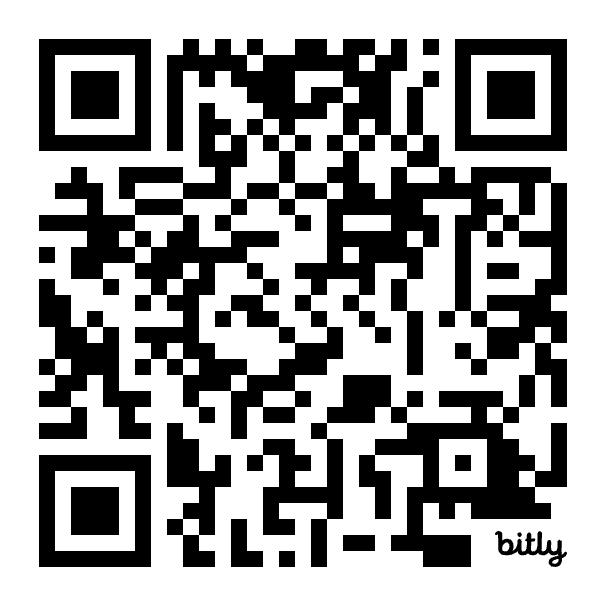

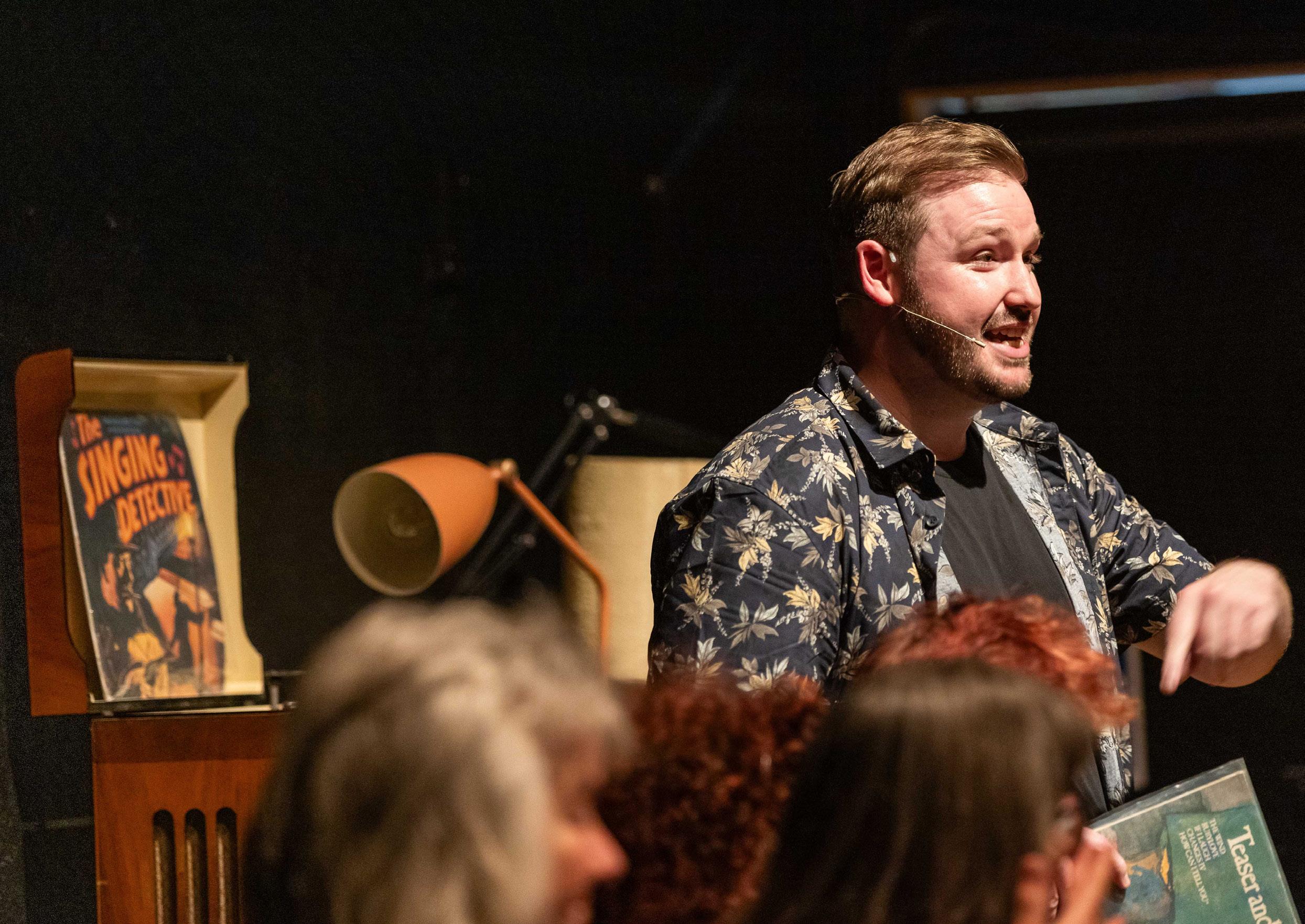

Songs and artists used in the original production:
• “Gloomy Sunday” by Billie Holiday
• Cab Calloway
• John Coltrane/Bill Evans
• “Free Jazz” by Ornette Coleman
• “Drown in My Own Tears” by Ray Charles
• “My Melancholy Baby” by Ella Fitzgerald
• “At Last” by Etta James
• “Move on Up” by Curtis Mayfield
• “I’m a Man” by Chicago
• “That’s Life” and “My Way” by Frank Sinatra
• “Wake Me Up Before You Go-Go” by Wham
• “Some Things Last a Long Time” by Daniel Johnstone
• “Into Each Life Some Rain Must Fall” by Ella Fitzgerald and the Ink Spots
One of the important parts of developing your report or constructing responses in the exam is to ensure that you have evidence from the performance and the creatives to support your ideas. This pack includes interviews that provide you with that supporting evidence and also prompts you to think about the wider context; social, political, historical and geographical ideas in the performance. Complete the following activity to create a glossary of evidence.
Read through the interview with Tim Bain and the notes on the use of music, including listening to the curated Spotify playlist. Compile a detailed glossary of quotes either digitally or in writing. Use this glossary to support you in the remainder of the activities in this pack and for revision or reference later in the year.
• Highlight important quotes and curate them underneath headings that they relate to: drama components, themes/messages, director/designers concept.
• Create another heading called ‘wider context’ and explore whether these quotes would support you to explore the deeper ideas of the performance.
• Did you learn something new from the interview? What has it made you think about - make notes.
In a play like Every Brilliant Thing, where staging is minimal, the use of props is particularly important when telling a story. If you choose to write about props in your report or in your exam at the end of the year, you will want to have thought about the purpose of each prop to the character and the story being told. You will also need to support your ideas with specific examples from the performance. This activity will help you to unpack each prop and compile detailed notes.
In pairs create a props inventory using the following table to support you. You can format this inventory any way you would like, the table is just a starting point.
Prop + Description
Extension activity: Once you have created your props inventory, choose one prop that you think was particularly meaningful in the performance. Write a short piece of writing about why this prop helped to do one of the following: build tension, create mood or establish a sense of time/place. Include a sketch with annotations.
Deciding to stage this performance in the round allows the director and actors to create a world of characters and places and to build a sense of rapport with the audience in order to tackle such sensitive subject material. In order to create the world of the play the director and designer also need to think about what fills that space and how the actor moves around in it.
Sketch out the space, ensure you add in set pieces, the lamps used, the bookshelf and where specific props came from. Add annotations about why the placement of set pieces and props helps to create a sense of place, time and also supports the building of the world of the play.
Extension activity: Storyboard a moment from the performance using your sketch as a starting place. You should aim to map out that moment over at least three storyboard frames and provide as much detail as possible, including how the actor moved around the space. Add quotations you think might be important or relevant.

As you experience the world of theatre, you will encounter various techniques and devices that playwrights and performers use to engage audiences and create unique theatrical experiences. One of these techniques is known as “breaking the fourth wall,” where characters directly address or acknowledge the audience, blurring the boundary between fiction and reality.
What is Breaking the Fourth Wall?
In traditional theatre, the “fourth wall” refers to the imaginary barrier between the actors on stage and the audience. Breaking the fourth wall occurs when this barrier is intentionally breached, allowing characters to interact with or address the audience directly. This technique can range from subtle acknowledgments to overt interactions that invite audience participation such as what you will experience in ‘EveryBrilliantThing’.
Why Break the Fourth Wall?
Breaking the fourth wall can serve several purposes in theatre, including:
• Enhancing audience engagement and immersion.
• Adding humor, intimacy, or emotional resonance to a performance
• Providing commentary on the theatrical experience or broader social issues.
• Creating opportunities for audience participation or interaction.
It is not just plays that use this technique however, many movies also break the fourth wall by addressing the audience directly. There are classic examples like BlazingSaddles or FerrisBeuller’sDayOff through to more recent movies like Deadpool where the main character pauses the action at times to make witty asides or to comment on a situation.


Natasha,Pierre&TheGreatCometof1812
by Dave Malloy:This musical adaptation of a section of Leo Tolstoy’s “War and Peace” features characters who frequently address the audience directly. The character of Pierre will often break the fourth wall to narrate, comment on the action, and share his inner thoughts and feelings with the audience.
ThePlayThatGoesWrong
by Henry Lewis, Jonathan Sayer, and Henry Shields:
A comedic farce about a hapless amateur theatre group staging a murder mystery, “The Play That Goes Wrong” includes numerous instances of breaking the fourth wall. Characters address the audience to apologize for mishaps, acknowledge technical difficulties, or comment on the absurdity of the situation, adding to the humour and chaos of the play.
Hamilton by Lin-Manuel Miranda:
While not a traditional breaking of the fourth wall, “Hamilton” features moments where characters address the audience directly, inviting them into the narrative and providing commentary on historical events. The character of Aaron Burr serves as the narrator of the story, frequently addressing the audience and offering his perspective on the events unfolding on stage.

TheCuriousIncidentoftheDogintheNight-Time
by Simon Stephens:Adapted from Mark Haddon’s novel, this play follows a young boy with autism as he investigates the mysterious death of a neighbour’s dog. The protagonist, Christopher, often addresses the audience as if they were his confidants, sharing his thoughts, fears, and observations about the world around him.
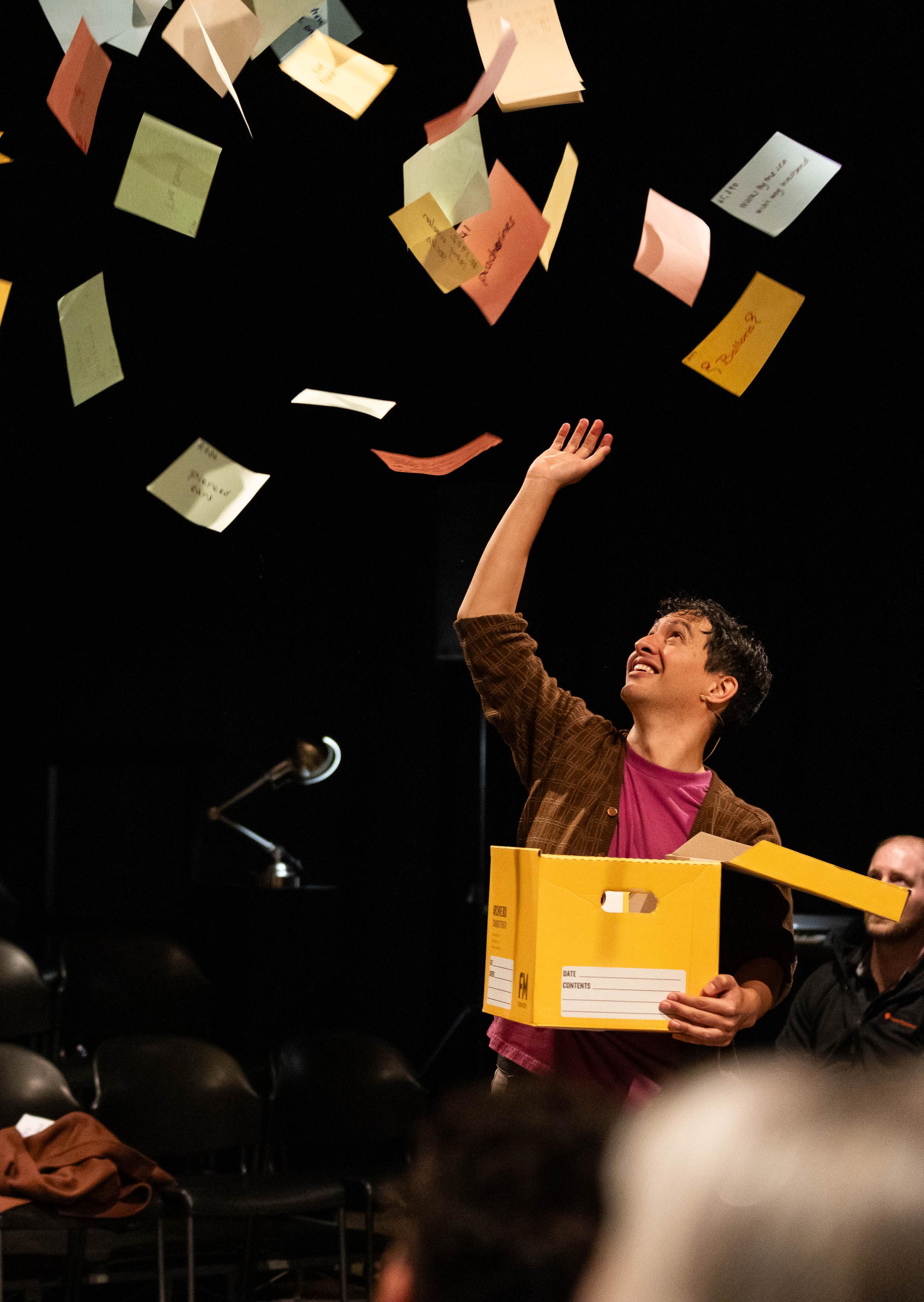
In this section of information, the question of ‘why’ is posed and reasons are given, with examples from other performances/media. Before getting into the more practical activities in this section, it is important to unpack how the convention of breaking the fourth wall was an effective way of telling this particular story.
Bus stop brainstorming. Split into four groups, with each group taking one of the points below;
• Enhancing audience engagement and immersion.
• Adding humour, intimacy, or emotional resonance to a performance.
• Providing commentary on the theatrical experience or broader social issues.
• Creating opportunities for audience participation or interaction.
For the first ten minutes, list as many examples from the performance where the actor broke the fourth wall for that purpose. Make sure you put details about that moment in the performance, such as where the actor was standing, quotes if possible, technology used in this moment and how drama elements were enhanced.
After ten minutes each group moves around to a new heading and adds more examples from the performance. The time at each point should diminish each round, as more ideas are compiled. Save the brainstorms in a central place so that you can use them for individual revision or to prompt you to look into ideas when constructing your report or revising for your exam.

Choose one of the ‘brilliant things’ from the performance that you found funny, joyful or challenging. Use it as your provocation for a short devised scene. You need to use the following to create your performance:
• Break the fourth wall for a purposeful reason.
• Place your audience in an interesting configuration.
• Use narration as a way to tell part of the story.
• Try to juxtapose tension with humour.
When you perform you need to explain why you chose the brilliant thing and justify why you have put your audience in the configuration you have. Ask for feedback on your performance.
Reflection: Why is it important to juxtapose tension with humour? How does it support your audience?
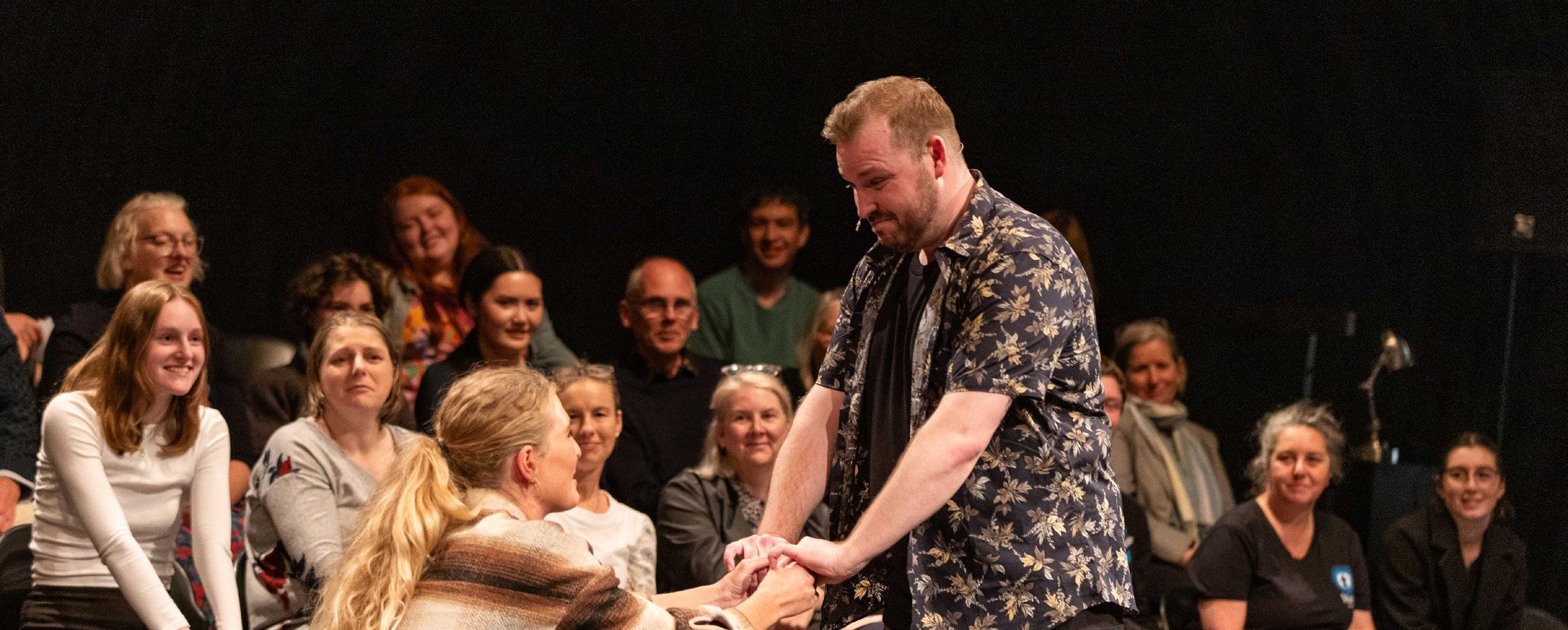


The play begins with a person who is dealing with a parent who attempts to take their own life. At age 7, the actor is taken from school to the hospital by his father who’s only words are “Your mother has done something stupid”. Upon seeing him at the hospital, his mother simply says “not him”.
Throughout the play he must navigate this situation on his own. His father closes his study door on him, using music as a shield. His mother meets him with silence whenever an opportunity arises to open up. Apart from the use of music, the silence in the house is clearly communicated. The words that the young character hears are words that do not help him, do not offer him anything in the way of support. It is from here that he creates the list, in an attempt to offer reasons for his mother to live.
Connecting the audience and the actor helps create a sense of all being present, all sharing in the experience with each other and a sense of support for each other. Having the individual audience members reading the list helps communicate that we are there connecting with the actor, we hear him. We give him our own little brilliant thing.
When his marriage breaks down and his wife encourages him to seek help, he tells us, “That made me so angry. I knew what depression was and I knew I was fine”, demonstrating an all too natural response of denial when faced with hard to face truths. He ends up watching her leave with “that horrible feeling when something is broken and can’t ever be fixed” thus creating a self fulfilling prophecy; but was it destined to be this way? Living with someone with depression can have a lasting impact. Finding a way to see the future can often require external help. “I have some advice for anyone who has been contemplating suicide.… it’s this: Things get better, they might not get brilliant but they get better.” Eventually he realises that the constantly developing list of brilliant things has become his own personal guide to a healthy life.
EveryBrilliantThingexplores the theme of resilience as the protagonist copes with their mother’s depression and navigates their own emotional struggles. The creation of the list of ‘brilliant things’ serves as a coping mechanism, helping the protagonist find solace and positivity in the face of adversity.
Despite the difficulties they face, the protagonist demonstrates remarkable resilience in coping with their mother’s depression and navigating their own struggles. The play highlights the importance of perseverance and finding ways to overcome situations that threaten to drag you down.
Having found his father closed off to him he begins a list, to remind his mother of all the things worth being here for. Rather than being just a way to reach his mother, the list becomes a way for the protagonist to navigate the depression and elation he feels as he grows into manhood and experiences the world around him.
Just before mentioning his mother’s third suicide attempt, the performer states,
“If you live a long life and get to the end of it without ever once having felt crushinglydepressed,thenyouprobablyhaven’tbeenpayingattention.”
This statement highlights the resilience we must cultivate. Whatever this comment reveals about his mother or himself, he understands and invites us to understand that life is not meant to always be easy, pleasant or smooth, but getting through those times is what counts.
We are introduced early on to the theme of imagination. In his memory of the first attempt, he invented a dialogue between himself and his father to fill the actual silence in the car, a series of “why?” questions. The imagined (or later recognized) answers offer us a window into this crucial issue.
“If you were able to know everything then life would be unliveable...we’d have no need to use our imaginations and our imaginations are what make life bearable.”
Because in order to live in the present we have to be able to imagine a future that will be better than the past. The author Duncan Macmillan highlights that the play is best presented in-the-round and with the house lights up throughout, leaving it all to our own imaginations.
“Atitsbesttheatreisaworkoutforourimaginationsandourcompassion,and hereithappenscollectivelywhichisincreasinglyrareandimportant.”
- Duncan MacmillanThe play encourages audiences to engage their own imaginations as they participate in the storytelling process. Audience members are invited to contribute to the list of “brilliant things,” adding their own suggestions and sharing in the collective experience of finding joy in everyday life. This interactive aspect of the play not only encourages a sense of connection and community but also encourages viewers to tap into their own creativity and imagination.
Hope
Hope is spread through the narrative, serving as a guiding force that helps the main character through difficult times, and shining as a light in the darkest moments with the promise of better days ahead.
Throughout the play, hope is portrayed as a transformative force that shapes the main character’s outlook on life and influences his interactions with others. Whether it’s through his efforts to cheer his mother up, his moments of connection with friends and strangers, or his own journey of self-discovery, hope is present throughout.
The theme of hope is also reflected in the play’s message of community and connection. As the main character shares his list of ‘brilliant things’ with the audience, others are invited to join them in celebrating life’s small pleasures. This collective experience creates a sense of connection among audience members, reinforcing the idea that hope is not a solitary pursuit but a shared journey that unites us.
Another example of hope that comes through is when his mother leaves his list neatly on his desk with the spelling corrected. This simple moment shows a glimmer of hope that maybe he is reaching his mother and maybe the future is looking a little brighter.
Once you have read through the themes curated above, split into four groups, each taking a theme.
In your group brainstorm around the following prompts:
• What character(s) were connected with this theme?
• How was technology used to highlight this theme?
• What lines of dialogue connect with this theme?
• How does this theme move the story forward?
• What do you think the writer’s purpose was in highlighting this theme?
You can collate your brainstorm in any way that suits your group; writing, in role performance, slides, sketches and annotations. Present your information back to the class and ask whether they can add extra ideas to your brainstorm.
Save all the groups brainstorms in a space where everyone can access it for revision.
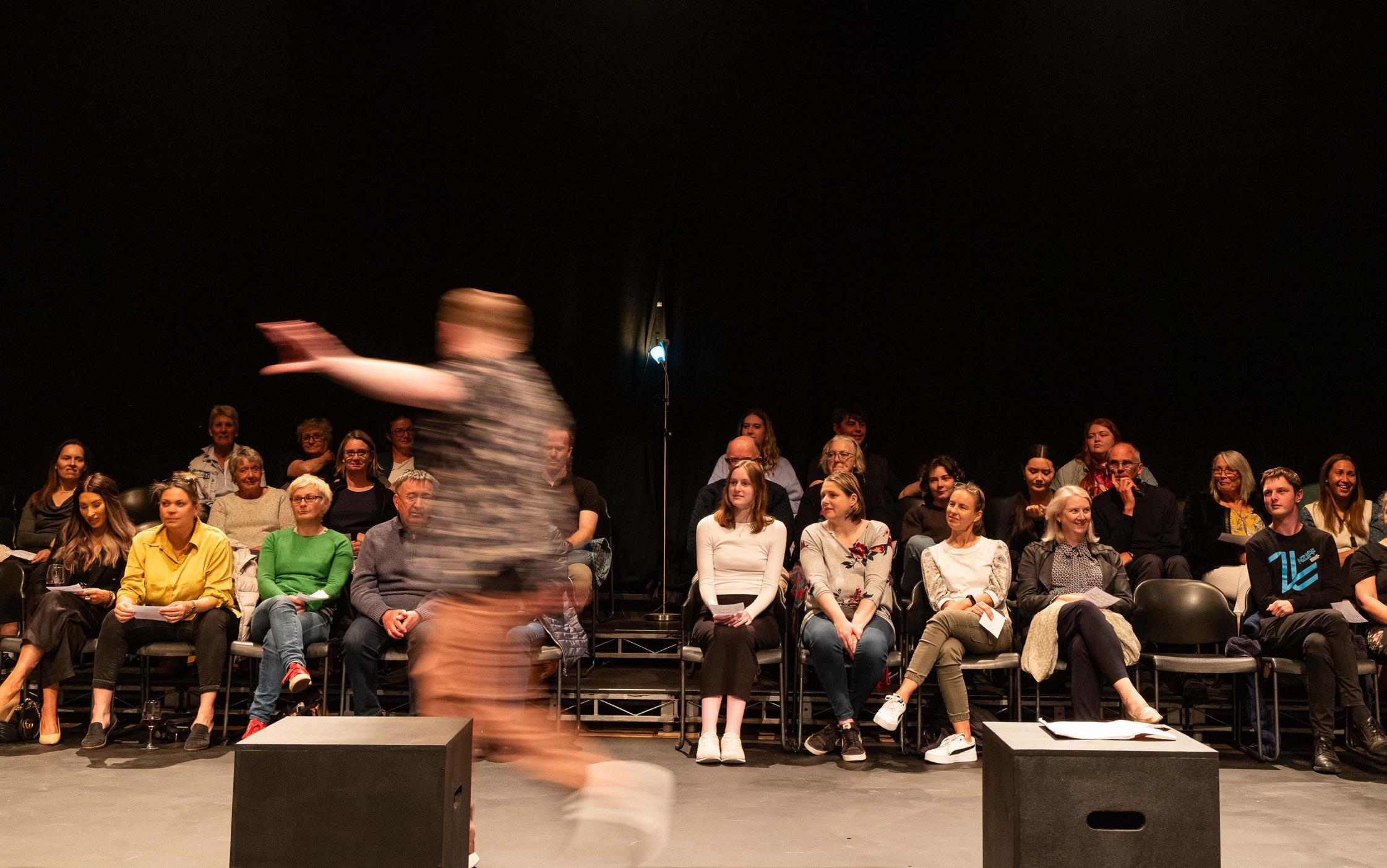
After viewing Every Brilliant Thing your teacher will support you to unpack the show with your peers and to construct an individual report which you will submit in October this year. The following questions and activities will support you to unpack the performance with the assessment specifications in mind.
You can find the specifications for both Level One externals via this link: Level One Assessment Specifications
Your report will be based around the following three points:
• Key message.
• The use of drama components; techniques, elements, conventions and techniques.
• Wairua of performance, which captures your personal response and experience of EveryBrilliantThing.
You could aim to weave the three points throughout your report.
Unpacking key messages:
When you get back to class, sit in a circle with a small bean bag or ball that you can pass across the room.
• Pass the ball or small bean bag across the circle when you have a key message to contribute.
• Someone should take note of all the ideas put forward.
There might be an obvious overriding message but try to think of all the messages that were communicated throughout the play, so that you can have a deep and robust discussion about the play.
Your focus question is:
Once you have collated a big list or brainstorm of the key messages, have a discussion as a class on ideas that you feel were the most important in the
performance; important could mean challenging, funny, thought provoking or entertaining.
• In groups or pairs choose one idea from the wider brainstorm.
• Write down how the message was communicated to the audience; through acting, directorial or design choices.
• Note down specific moments where the key message was highlighted to the audience (remember that this will be different from person to person, it is ok if your understanding is different from your partner).
• From your discussions do a short presentation back to the class about your key message, how it was highlighted in the show and why you thought it was important.
• Gain feedback and thoughts from your peers.
Individualactivity: Choose one of the key messages that haven’t been touched on and complete one of the following activities to explore whether you had a personal reaction to it:
• A voice note or vlog discussing what the key message was, how it was highlighted and how you connected with it.
• A sketch with annotations of a specific moment that highlighted this key message.
• A short essay (200 words) about the key message and why you connected to it.
Exploring moments where drama components were used effectively:
Before you start discussing EveryBrilliantThing, make sure you understand what techniques, elements, conventions and technologies are. Break down a glossary of words with your teacher and make sure you know how to use them when you are talking and writing about live performance.
Split into four groups with each group taking one component each.
• Note down important moments in the performance where that component highlighted the key message.
• Add brief sketches and annotate details of the moments as you discuss.
• Add notes, quotes (from the actor/director/designer or from the play) and your own thoughts.
Each group will share their information back to the class and upload all the information to a shared space; such as a Google Classroom, OneDrive or up on your classroom wall.
Individual activity: Looking at all the unpacking your class has done together around use of components, complete the following activity to support the construction of your report. Extending on the key message you have already used or a new one that means more to you. You can record this work in whatever way suits you best; writing, slides, vlog, voice note or in role (be creative)
• Choose a moment where this key message was highlighted by all or a combination of components.
• Explicitly explain the moment and the use of components.
• Add details, examples from the performance and quotes.
• Use specific drama terminology in every part of your response.
• Sketch and annotate if you think that will help you to elaborate your ideas.
Wairua of performance:
As part of your reflection on EveryBrilliantThing and in the construction of your report you will need to explore your own personal response and the ‘wairua of performance.’ Your teacher will have access to the unpacking of this standard which gives you a more detailed explanation and can explore this with you in class.
“Personalresponsewillbefromtheirperspective,aseitheranaudience member,orperformer.Theywillalsounderstandhowthewairuaofa performanceischannelledthroughtheperformers,andhowtheuseofdrama componentscaninfluencehoweffectivelyitisprojectedontotheaudience.”
-1.4Unpacking
Questions to ask yourself to explore your personal response to the performance:
• What did you feel during the performance?
• What thoughts did you have during the performance?
• What have you been feeling since?
• What have you been thinking about since?
• What do you need to discuss further with your teacher, your family or your peers?
• What conversations have you had?
Groupactivity: in small groups, brainstorm all the moments that the audience visibly reacted to during the performance.
• Why were they reacting to these moments?
• What was the actor doing at the time?
• What decisions did the designer and directors make in these moments?
• Did the audience’s reaction impact your thoughts, feelings or ideas at this moment?
Individualactivity: write or record a reflection based around the following prompt, incorporating responses to the questions above.
What thoughts, feelings or responses did the performance of EveryBrilliant Thing prompt you to think about? How did the decisions of the director/ designers, or the performance of the actor contribute to these thoughts, feelings or responses?
Once you have completed the activities outlined you can start to explore how you might use ideas, thoughts and evidence compiled to build your report. Remember it needs to be your own work and you can present your ideas in a way that suits you best.
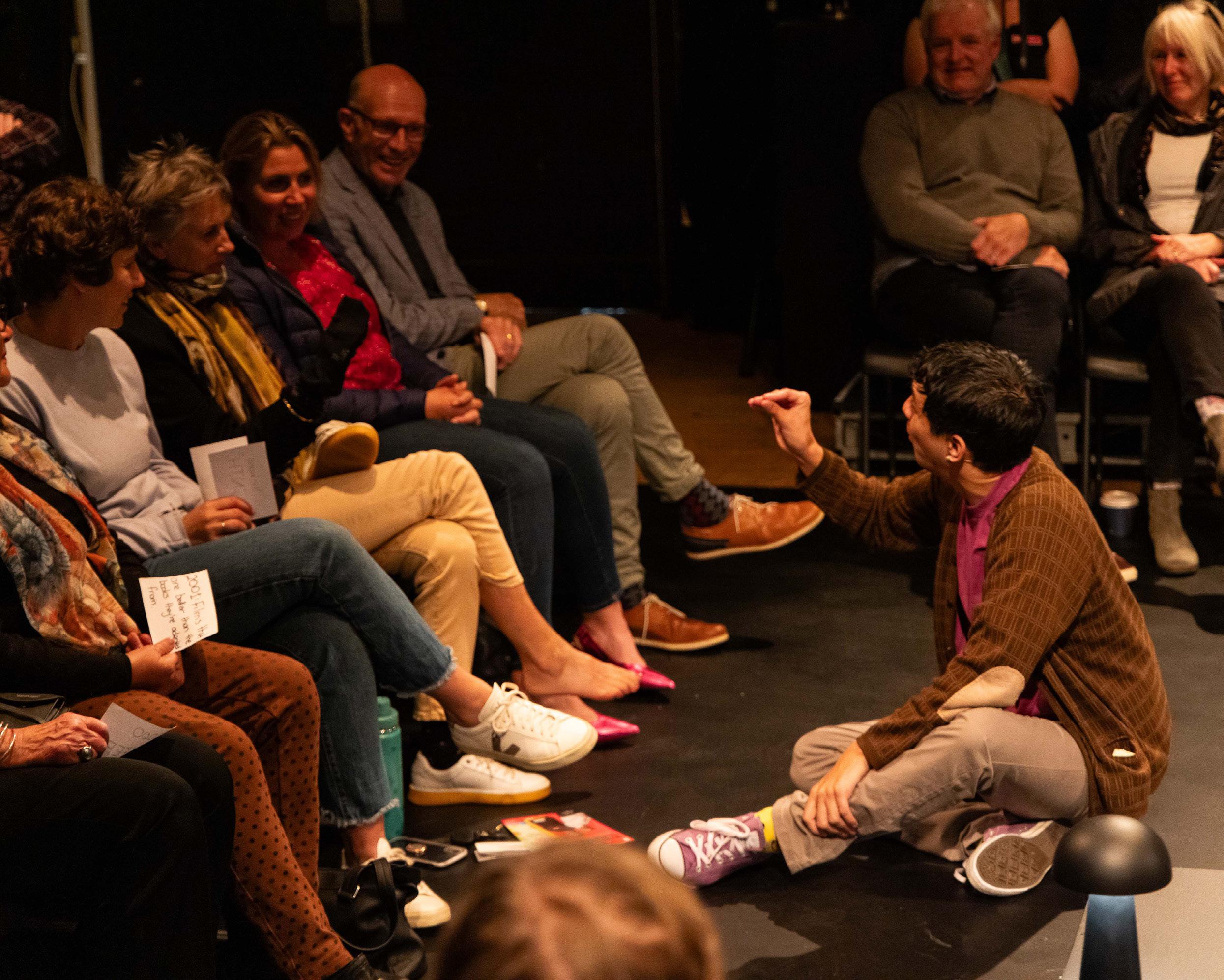

If you are a Level Two or Three student these revision questions are curated to support you to be able to answer your exam questions. You need to think carefully about the answers that come up as your work through the questions and how your thoughts, evidence and physical examples could be used in your exam responses.
The assessment specifications for both Level Two and Level Three are linked below:
Level Two: Level Two Assessment Specifications
At Level Two you “should be familiar with the use of drama elements, techniques, conventions, and technologies”. Questions may cover a combination of all four drama components.
Level Three: Level Three Assessment Specifications
At Level Three you will be expected to
• “Make connections between the director/designer’s concept(s) and the performance seen.”
• “Be familiar with the use of drama components such as elements, techniques, conventions, and technologies.”
• Think about wider context:
• “The performance as a whole.
• The playwright’s purpose.
• The nature and/or purpose of theatre as an art form
• The social or historical context. Questions may cover a combination of drama components such as elements, techniques, conventions, and technologies.”
Questions to help you think about the actors creation of character and their use of techniques:
• How did the actor use techniques to create his character? Give specific examples from the performance.
• How did the actor use their voice to create a connection with the audience?
• How did the actor use their body language and use of the space to build a connection with the audience?
• Why was it important that the actor’s use of tone and pitch was empathetic with the subject matter of the performance?
• How did the actor use gesture and posture to communicate the characters age, thoughts and feelings?
• How did the actor use the space to create a sense of time and place in a specific moment in the performance?
• How did the actor use space/proximity and eye contact when breaking the fourth wall with the audience? Why was this important to the story being told?
• How did the actor use pace and body energy to move the story along? Give specific examples from the performance.
Questions to help you think about the use of conventions in performance: “strategiesestablishedtomakemeaningandconnecttowidercontext.”
• Discuss a moment in the performance where a drama convention was used effectively to move the story forward.
• Explain how a convention or a combination of conventions were used in a performance. How did this use of conventions create a sense of mood or atmosphere?
• How did the use of a convention build tension during an important moment in the performance.
• Discuss how the use of a convention helped to create meaning in a moment in the performance?
• Discuss the purpose of breaking the fourth wall and how it supported the telling of the story.
• Discuss how the use of a convention or combination of conventions in a specific moment helped you think about the big ideas and themes of the play.
• What was the wider context (socially, historically, politically or geographically) that this moment linked to?
Questions to help you think about the directors choices and use of drama elements:
• Choose a moment in the performance where you think the director tried to build tension.
• How did the director build mood and atmosphere?
• Discuss what you think the director’s concept was and what key messages they wanted the audience to focus on.
• Discuss how the director collaborated with the designers to focus the audience on the key messages, ideas and themes of the performance?
• Discuss how the director created a sense of time and place in the choices they made around staging. Give physical examples from the performance.
• Discuss why you think this play is important for audiences to watch. Why this play, at this point in time?
• Discuss how this play heals, entertains, educates or transforms the audience and the directors role in communicating that message.
Questions to help you think about design and use of technologies: reference the design information in this pack to support your answer.
• How did lighting and the choices the designer made create mood and atmosphere?
• What was the purpose of the lampshades and their position in the space?
• Make notes on the song choice and how they supported the story being told.
• How did sound give a sense of time and place to the performance?
• Discuss the significance of the props used in the performance and how they communicated the themes, ideas, messages and symbols.
• Make notes on the purpose of the simple set and mundane costuming. Why was it important in this particular type of story?
• How were the ‘brilliant things’ represented in the performance? Why was it important to represent them in different ways?
